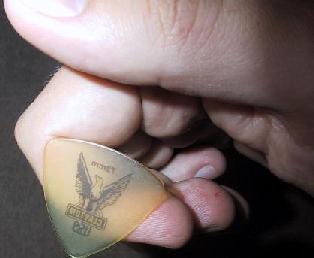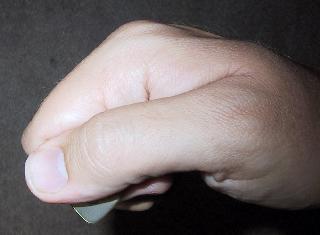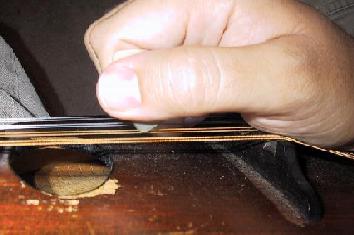[Home] [News] [Bio] [Technique]Some Mandolin Techniques & Tricks
| ||||||||||||||
Holding the Pick | |
|---|---|
| I've had some people mail me questions asking about techniques I use to play the mandolin, so I thought it might be informative to list some of my favorite mandolin tricks here. I play with Clayton Ultem .72mm rounded-triangle picks (pictured on the right). As you can see in the picture, I hold the pick with the point sticking out just past the first knuckle of my first finger. |

|

|
I close my thumb over the pick as pictured, and my wrist is loosley over the bridge of the mandolin. Most of the picking motions comes straight from the wrist, with slight forearm movements to move to different strings. (Is it just me, or does that remind you of Señor Wences with an earring..) |
| Here's what the whole operation looks like on a mandolin. In this picture I was actually trying to hold the mandolin in place with my right hand while taking the picture, so it looks like I'm clamping my wrist down tight on the bridge. Normally you don't want to do this, it dampens the sound (though it can make a nice effect when done intentionally). |

|
| Another thing I should mention, the overall grip is very relaxed. When using a pick this heavy, I hold on to it just tightly enough that it doesn't slip, with a variable slight twist against the strings when I triplet (this shows up a bit in the video clip below). My whole right arm is very relaxed, just enough pressure on my lower forearm over the tailpiece to hold the mandolin in place on my stomache. I don't usually use a strap with the mandolin unless I am standing, and even then sometimes I won't. The first knuckle on my little finger occasionally knocks on the face of the mandolin (you can hear a little of this in the "Stirling Castle" track on my CD!), a side effect of not having an "anchor finger" on the face of the instrument. I mostly keep my hand in the right place by holding the mandolin in place with my forearm on the tailpiece area. | |
Picking Patterns |
|
|
This topic came up on the mandoilin cafe
message boards last week. When picking an Irish Jig in 6/8 time, the beat
emphasis is on the first and 4th beats, which normally implies a downstroke
picking motion for those 2 notes. Thinking about that a little tells you that that
you probably aren't going to pick down-up-down up-down-up for those notes. Many
teachers & fine players I have met advocate picking jigs down-up-down
down-up-down (DUD DUD).
I mostly use the down-down-up down-down-up (DDU DDU) pattern. There are a couple advantages to this- first of all, you get a very nice "lift" or snap to the up-beat, I picked this technique up from playing for set dance ceilidhs. I'm not sure I ever really thought about it consciously, but it is a very easy pattern to pick with an exacting rhythm and I just noticed one day that I was doing it. One common problem when you are learning technique is to have your rhythm falter when you are playing a triplet or complex part of a tune. Basically your hands are rebelling a bit against trying to fit in a change in the rhythm of picking. Here's where DDU DDU comes in nicely- if you want to put a triplet at the end of the beat (the last two quarter notes of the set of three), you can pick measures D UDU D UDU | D UDU D UDU. It's actually very easy once you practice it a bit, it's basically the same picking motion for a basic unornamented reel. For triplets at the end of a jig beat, this technique is probably the *easiest* one to use. Personally, I have always held the 1st and 4th notes in a measure longer than 1 beat, probably about 1 1/2 beats even, compressing the last two notes in rapidly at the end. For me, it's always been easier to use that pause to bring the pick up for the second downstroke there, rather than between the 3rd & 4th notes where the pause feels much shorter to me. The text above doesn't really describe as well as this video clip does (5Mb!). |
|